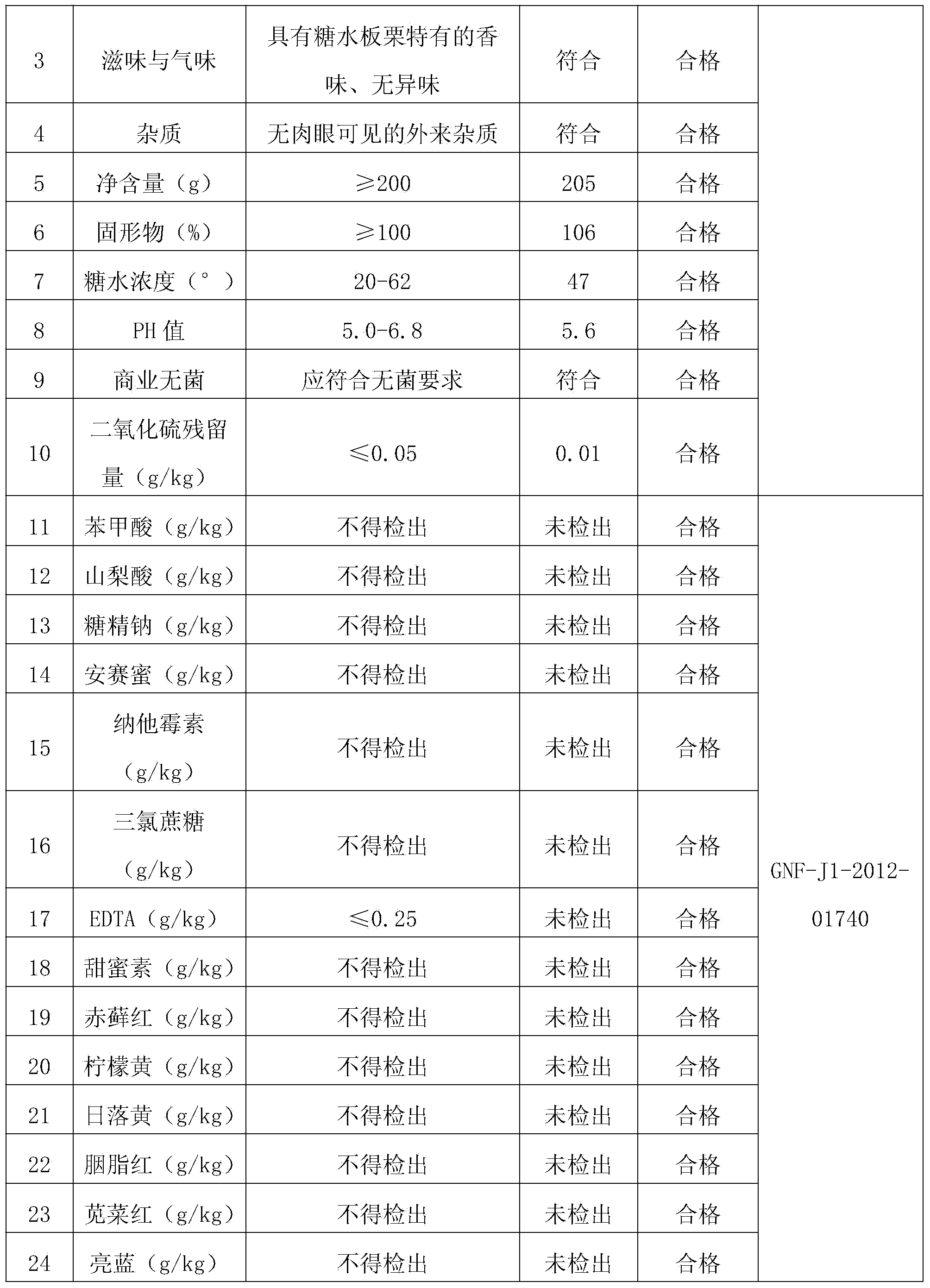Processing method for sweet-water castanea mollissimas
A processing method and technology of chestnut, applied in the fields of application, food preparation, food science, etc., can solve the problems of wasting water and reducing processing efficiency, and achieve the effect of reducing water consumption, improving processing efficiency and soft tissue
- Summary
- Abstract
- Description
- Claims
- Application Information
AI Technical Summary
Problems solved by technology
Method used
Image
Examples
Embodiment 1
[0016] Embodiment 1: the processing of chestnut in syrup
[0017] a), remove the shell and astringent skin of the chestnut, then peel off the yellow skin on the surface of the chestnut until its surface is smooth;
[0018] b), add low sodium sulfite and edetate disodium to the chestnut meat and boil it and wash it, the addition amount of low sodium sulfite and edetate disodium in the chestnut meat is 0.4g / kg and 0.25g / kg respectively In this step, the chestnut meat is boiled in three stages. The first stage is boiled at 62°C for 60 minutes, the second stage is boiled at 70°C for 60 minutes, and the third stage is boiled at 90°C for 2 hours. Rinse the boiled chestnut meat with running water for 10 minutes.
[0019] c), boil the chestnut meat obtained in step b with water for 30 minutes at 80° C., and then rinse with running water for 15 minutes;
[0020] d) Drain the rinsed chestnut meat, put it into the sugar solution for candiing, cool the candied chestnut meat for 12 hours...
Embodiment 2
[0022] Embodiment 2: the processing of chestnut in syrup
[0023] a), remove the shell and astringent skin of the chestnut, then peel off the yellow skin on the surface of the chestnut until its surface is smooth;
[0024] b), add low sodium sulfite and edetate disodium to the chestnut meat and wash it after boiling, the addition amount of low sodium sulfite and edetate disodium in the chestnut meat is 0.3g / kg and 0.2g / kg respectively In this step, the chestnut meat is boiled in three stages. The first stage is boiled at 65°C for 30 minutes, the second stage is boiled at 73°C for 30 minutes, and the third stage is boiled at 94°C for 1 hour. Rinse the boiled chestnut meat with running water for 8 minutes.
[0025] c), boil the chestnut meat obtained in step b with water for 25 minutes at 85° C., and then rinse with running water for 12 minutes;
[0026] d) Drain the rinsed chestnut meat, place it in sugar solution for candiing, cool the candied chestnut meat for 12 hours unti...
Embodiment 3
[0028] Embodiment 3: the processing of chestnut in syrup
[0029] a), remove the shell and the astringent skin of the chestnut, then peel off the yellow skin on the surface of the chestnut until its surface is smooth;
[0030] b), add low sodium sulfite and disodium edetate to the chestnut meat, boil it and wash it, the addition amount of low sodium sulfite and disodium edetate in the chestnut meat is 0.2g / kg and 0.15g / kg respectively In this step, chestnut meat is boiled in three stages. The first stage is boiled at 63°C for 45 minutes, the second stage is boiled at 71°C for 40 minutes, and the third stage is boiled at 92°C for 1.5 hours. , Rinse the boiled chestnut meat with running water for 5 minutes.
[0031] c), boil the chestnut meat obtained in step b with water for 20 minutes at 80° C., and then rinse with running water for 10 minutes;
[0032]d) Drain the rinsed chestnut meat, place it in sugar solution for candiing, cool the candied chestnut meat for 10 hours unti...
PUM
 Login to View More
Login to View More Abstract
Description
Claims
Application Information
 Login to View More
Login to View More - R&D
- Intellectual Property
- Life Sciences
- Materials
- Tech Scout
- Unparalleled Data Quality
- Higher Quality Content
- 60% Fewer Hallucinations
Browse by: Latest US Patents, China's latest patents, Technical Efficacy Thesaurus, Application Domain, Technology Topic, Popular Technical Reports.
© 2025 PatSnap. All rights reserved.Legal|Privacy policy|Modern Slavery Act Transparency Statement|Sitemap|About US| Contact US: help@patsnap.com



